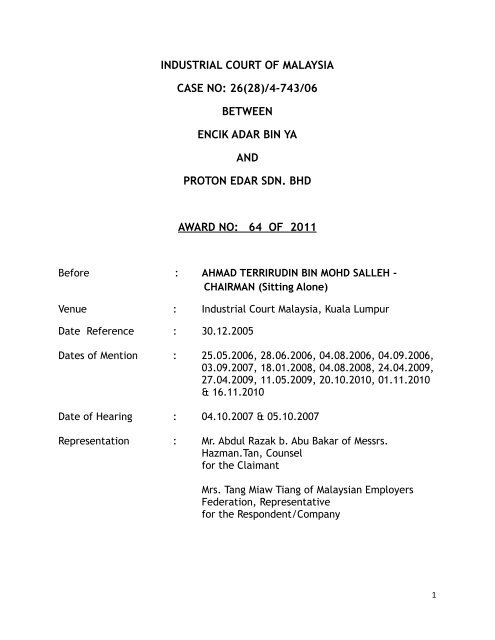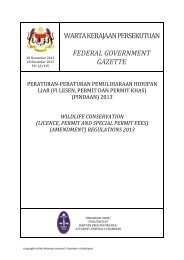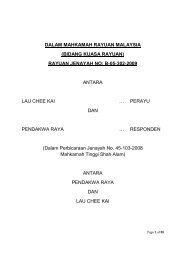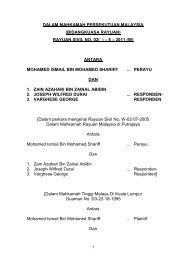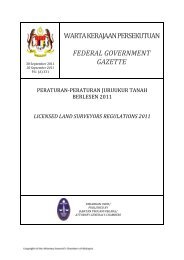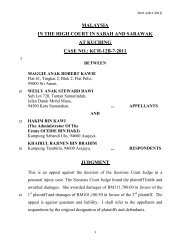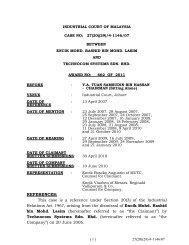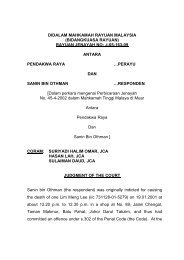4-743/06 between encik adar bin ya and proton ... - Industrial Court
4-743/06 between encik adar bin ya and proton ... - Industrial Court
4-743/06 between encik adar bin ya and proton ... - Industrial Court
You also want an ePaper? Increase the reach of your titles
YUMPU automatically turns print PDFs into web optimized ePapers that Google loves.
INDUSTRIAL COURT OF MALAYSIA<br />
CASE NO: 26(28)/4-<strong>743</strong>/<strong>06</strong><br />
BETWEEN<br />
ENCIK ADAR BIN YA<br />
AND<br />
PROTON EDAR SDN. BHD<br />
AWARD NO: 64 OF 2011<br />
Before : AHMAD TERRIRUDIN BIN MOHD SALLEH -<br />
CHAIRMAN (Sitting Alone)<br />
Venue : <strong>Industrial</strong> <strong>Court</strong> Malaysia, Kuala Lumpur<br />
Date Reference : 30.12.2005<br />
Dates of Mention : 25.05.20<strong>06</strong>, 28.<strong>06</strong>.20<strong>06</strong>, 04.08.20<strong>06</strong>, 04.09.20<strong>06</strong>,<br />
03.09.2007, 18.01.2008, 04.08.2008, 24.04.2009,<br />
27.04.2009, 11.05.2009, 20.10.2010, 01.11.2010<br />
& 16.11.2010<br />
Date of Hearing : 04.10.2007 & 05.10.2007<br />
Representation : Mr. Abdul Razak b. Abu Bakar of Messrs.<br />
Hazman.Tan, Counsel<br />
for the Claimant<br />
Mrs. Tang Miaw Tiang of Malaysian Employers<br />
Federation, Representative<br />
for the Respondent/Company<br />
1
Reference:<br />
The reference of the Honourable Minister of Human Resources, Malaysia<br />
is regarding the dismissal of Encik Adar <strong>bin</strong> Ya (“the claimant”) by Proton<br />
Edar Sdn. Bhd. (“the company”).<br />
AWARD<br />
(NO: 64 OF 2011)<br />
This is a Ministerial reference to the <strong>Industrial</strong> <strong>Court</strong> under section 20 (3)<br />
of the <strong>Industrial</strong> Relations Act 1967 (“the Act”) made on 17 March 20<strong>06</strong><br />
for an award in respect of the dismissal of Adar <strong>bin</strong> Ya (“the claimant”)<br />
by Proton Edar Sdn Bhd (“the company”).<br />
Background<br />
The case was heard by the previous Y.A. Chairman of <strong>Industrial</strong> <strong>Court</strong> No.<br />
28 <strong>and</strong> he has been transferred from <strong>Industrial</strong> <strong>Court</strong> effective in March<br />
2009. As such, the learned President of the <strong>Industrial</strong> <strong>Court</strong> transferred<br />
the matter to this Division on 8 December 2010. It is pertinent to note<br />
that counsel for both parties on 16 November 2010 have agreed for this<br />
<strong>Court</strong> to deliver the award.<br />
After having carefully perused, examined <strong>and</strong> considered the notes of<br />
evidence from both the company as well as the claimant, the <strong>Court</strong> does<br />
2
not find any problem in h<strong>and</strong>ing down the Award, as the issue is<br />
straightforward, plain <strong>and</strong> clear.<br />
Brief Facts Of The Case<br />
The claimant commenced employment with the company as a Workshop<br />
Manager on 5 April 1996 at a salary of RM2,600.00. The claimant alleged<br />
that he was unfairly dismissed by the company on 6 May 2004. The<br />
claimant's last drawn salary was RM5,022.00 per month. However, the<br />
company did not agree with the claimant's allegation <strong>and</strong> contends that<br />
the claimant was dismissed for committing two serious misconducts. It is<br />
important to note that a domestic inquiry was conducted by the company<br />
against the claimant on 22 April 2004 <strong>and</strong> the domestic inquiry panel<br />
found him guilty on charges no. 2 <strong>and</strong> no. 3. For ease of reference the<br />
notice for domestic inquiry is reproduced below:<br />
3
The Law<br />
In relation to misconduct the court refers to the case of Menara<br />
Panglobal Sdn. Bhd. v. Arokianathan Sivapiragasam [20<strong>06</strong>] 2 CLJ 501 a<br />
case again by the <strong>Court</strong> of Appeal which reiterated the principle that the<br />
main <strong>and</strong> only function of the <strong>Industrial</strong> <strong>Court</strong> in dealing with a reference<br />
under section 20 of the Act is to determine whether the misconduct or<br />
irregularities complained of by the company as to the grounds of<br />
dismissal were in fact committed by the workman <strong>and</strong> if so, whether such<br />
grounds constitute just cause or excuse for the dismissal.<br />
It is trite <strong>and</strong> a well known jurisprudence that for dismissal cases, the<br />
employer bears the burden of proof that the dismissal was with just<br />
cause or excuse on a st<strong>and</strong>ard of proof which is on a balance of<br />
probabilities; see Goon Kwee Phoy v. J & P Coats (M) Bhd. [1981] 1 LNS<br />
30; [1981] 2 MLJ 129; Telekom Malaysia Kawasan Utara v. Krishnan Kutty<br />
Sanguni Nair & Anor [2002] 3 CLJ 314.<br />
Issues<br />
Before proceeding further, it is mundane to state here that the <strong>Court</strong> will<br />
only determine the validity of the claimant's dismissal in accordance with<br />
his termination letter. In Gan Chee Ming v. TN Forklift Holdings Sdn.<br />
Bhd. & Anor [2001] 6 CLJ 13, His Lordship Faiza Tamby Chik J said at p.<br />
18 of the following:<br />
5
“It is trite that the <strong>Industrial</strong> <strong>Court</strong>'s jurisdiction is limited to<br />
deciding whether the company had just reasons to dismiss the<br />
employee at the time of dismissal. The company cannot depend on<br />
events after the dismissal to justify the dismissal.”.<br />
Following the case of the Federal <strong>Court</strong> in the case of Milan Auto Sdn.<br />
Bhd. v. Wong Sen Yen [1995] 4 CLJ 449, the <strong>Court</strong> will determine two<br />
issues.<br />
Firstly to determine whether the misconduct complained of by the<br />
employer has been established <strong>and</strong> secondly whether the proven<br />
misconduct constitutes just cause or excuse for the dismissal.<br />
Evidence By The Parties<br />
Company's Case<br />
The company called 3 witnesses. The first witness for the company is Zul<br />
Emran <strong>bin</strong> Yaakob (COW1). He testified orally in <strong>Court</strong> that at the<br />
material time he was the Marketing Executive for Tsubasa System<br />
Company. He confirmed that he did prepare a written report (page 12 of<br />
enclosure 7) regarding the incident involving the claimant <strong>and</strong> Mr.<br />
Sugimoto (Sugimoto). In his oral evidence <strong>and</strong> written report he stated<br />
that on 22 March 2004 at about 1.30 pm to 2.00 pm while sitting at his<br />
place the claimant <strong>and</strong> Sugimoto came to his office. Then he said he<br />
heard the claimant raised his voice to Sugimoto <strong>and</strong> the quarrel started<br />
<strong>between</strong> them. COW1 said that he went out of the office <strong>and</strong> informed<br />
Mr. Hatai (Hatai) <strong>and</strong> Hatai took them out of the office <strong>and</strong> brought them<br />
to the car park behind the office. However, after 2 to 3 minutes later,<br />
6
Miss Zarina (Zarina) shouted to him that the said two are starting to fight<br />
so he went to the place <strong>and</strong> try to break the scuffle. At that place also<br />
he saw Mr. Mahadi (Mahadi) was lying on the floor with a screwdriver in<br />
his h<strong>and</strong> <strong>and</strong> Sugimoto was still kicking him. COW1 then managed to stop<br />
Sugimoto <strong>and</strong> brought him to the front portion of the area <strong>and</strong> while<br />
waiting for the car he said the claimant came to them with a “parang”<br />
<strong>and</strong> the claimant also told Sugimoto not to come again to the shop. After<br />
the car came, COW1 said they left the place with Hatai. COW1 also<br />
admitted that he did give evidence during the DI. During examination in<br />
chief, COW1 testified that when Sugimoto <strong>and</strong> Mahadi were fighting the<br />
claimant was nearby <strong>and</strong> he only observed <strong>and</strong> did not do anything. COW1<br />
further testified that he did not see Sugimoto kicked or hit the claimant.<br />
To give a clearer picture of the incident, the claimant also drew a sketch<br />
plan (enclosure 11) of the area indicating the place where the claimant<br />
came with a “parang” ( the place was marked as “Z” in the sketch plan).<br />
According to COW1, the claimant was angry when he spoke to Sugimoto<br />
<strong>and</strong> at that time he was showing the “parang” to Sugimoto. COW1<br />
confirmed that Sugimoto did not harm the claimant but was more<br />
interested to go back to the where Mahadi was. He also confirmed that<br />
he did not see Sugimoto hitting the claimant. The second witness for the<br />
company is Zarina <strong>bin</strong>ti Che Omar @ Mahmud. COW2 also gave oral<br />
evidence in court. In her oral testimony, she said that at the material<br />
time she worked as the Administrative Assistant of the company.<br />
Pertaining to the said incident, COW2 confirmed that she had prepared a<br />
written report (page 11 of enclosure 7) <strong>and</strong> also gave evidence as a<br />
witness in the Domestic Inquiry (DI) against the claimant. Regarding the<br />
7
incident <strong>between</strong> the claimant <strong>and</strong> Sugimoto, COW2 supported the<br />
testimony of COW1. COW2 further added that she did not see Sugimoto<br />
punching the claimant. She also remembered that the claimant did point<br />
the “parang” to Sugimoto <strong>and</strong> told him in angry tone to go back <strong>and</strong> if he<br />
did not the claimant said he will chop Sugimoto. The last witness for the<br />
company is Mohd Aswan <strong>bin</strong> Abdullah (COW3). Vide his witness statement<br />
(COWS3 (a)), COW3 said that when the DI was convened he was the Sales<br />
Manager for Jalan Ipoh Branch, Kuala Lumpur. COW3 confirmed that the<br />
DI was convened on 22 April 2004 <strong>and</strong> apart from YM Engku Ahmad<br />
Kamel <strong>and</strong> Encik Suhairi Saad, he was also one of the panel members for<br />
the DI. COW2 said that the DI panel followed the procedures <strong>and</strong> the<br />
claimant also was given the opportunity to cross-examine the witnesses<br />
for the company. He further added that during the said DI also the<br />
claimant called 5 witnesses. As for the DI notes (enclosure 8), COW3<br />
confirmed that the notes recorded was what exacly taken during the DI<br />
proceeding. Finally, he said the DI panel found the claimant guilty only<br />
on 2 nd <strong>and</strong> 3 rd charges <strong>and</strong> recommended that the claimant be dismissed.<br />
Claimant's Case<br />
Vide his witness statement (CLWS1 (a), the claimant stated that on 22<br />
March 2004, the company's workshop received a polishing <strong>and</strong> body<br />
coating order for Proton Waja with registration number WLN 5849.<br />
However, due to the mistake done by one of the company's technician<br />
during the polishing process, there were some scratches at the front<br />
bumper. He further stated that the scratches needed to be repainted<br />
<strong>and</strong> as a result the delivery of the car to the customer had to be delayed.<br />
8
According to the claimant, upon knowing this, Sugimoto who is the<br />
coordinator of the company became upset <strong>and</strong> scolded him for the<br />
mistake done by the technician. He further alleged that despite politely<br />
explaining the situation to Sugimoto he is still not satisfied <strong>and</strong> rudely<br />
pointed finger at him. The claimant then requested Sugimoto not to<br />
point his finger at him <strong>and</strong> not to interfere with operation of the<br />
workshop. At that time he said Hatai came <strong>and</strong> took both of them<br />
outside the workshop <strong>and</strong> again he requested Sugimoto to talk to him<br />
politely <strong>and</strong> not to point finger at him. The claimant alleged that when<br />
he tried to leave Sugimoto <strong>and</strong> walked back to his office Sugimoto<br />
grabbed his shirt around his shoulder but he told Sugimoto to let him go<br />
<strong>and</strong> he further said to Sugimoto that should he wish to talk to him he<br />
must do it properly. However, he said Sugimoto was not happy with his<br />
explanation <strong>and</strong> grabbed him by the collar <strong>and</strong> lifted him off his feet with<br />
his right h<strong>and</strong>. At the same time he said Sugimoto's left h<strong>and</strong> was<br />
clenched into a fist <strong>and</strong> was poised to give him a punch to his face or<br />
head. Acting in self defence, the claimant said he br<strong>and</strong>ished a “parang”<br />
which he took out from the car boot at Sugimoto <strong>and</strong> warned him not to<br />
come any closer. The claimant denied that the “parang” was displayed in<br />
an aggressive attacking manner <strong>and</strong> claimed that it was done as a self<br />
defence <strong>and</strong> in fear of grave physical harm by Sugimoto.<br />
With regards to the DI, the claimant alleged that Sugimoto was not called<br />
during the inquiry. He also claimed that he knew one of the panel<br />
members that is Suhairi Saad for almost ten years since he has worked<br />
with in the company. The claimant's second witness is Mahadi <strong>bin</strong> Ariff.<br />
9
Vide his written statement (CLWS2 (a)), he informed the court that at the<br />
material time he worked with the company as Technician Class 3.<br />
Pertaining to the incident, CLW2 confirmed that he is the Mahadi referred<br />
to by COW1 <strong>and</strong> COW2 in their evidence. He further confirmed that the<br />
claimant did br<strong>and</strong>ish a “parang” to Sugimoto but it was done after<br />
Sugimoto refused to leave the workshop.<br />
Evaluation <strong>and</strong> Findings<br />
In this case, it is not disputed that the company did hold a DI against the<br />
claimant on 22 April 2004. Therefore, it is imperative to note that in<br />
instances where a DI has been held, the <strong>Industrial</strong> <strong>Court</strong>'s jurisdiction was<br />
limited to considering whether there was a prima facie case against the<br />
delinquent employee; see Bumiputra Commerce Bank Bhd. v. Mahkamah<br />
Perusahaan Malaysia & Anor [2004] 7 CLJ 77, where the High <strong>Court</strong> had<br />
also laid down the guidelines that the <strong>Industrial</strong> <strong>Court</strong> should first<br />
consider whether or not the DI was valid <strong>and</strong> whether the DI notes are<br />
accurate.<br />
After perusing the DI notes as in enclosure 8 (pages 1 to 18), the court<br />
discovers that the said notes as the accurate record of the proceeding.<br />
However, on the issue of the validity of the proceedings of the DI, the<br />
court finds that the conduct of the DI was improper or wanting. This is<br />
because the court notes that after reading the charges <strong>and</strong> before<br />
recording his plea, COW3 or any of the panel members did not ask the<br />
claimant whether he understood the charges. Secondly, based on the DI<br />
10
notes also, the court discovers that although the claimant was given the<br />
right to cross-examine the witnesses in the said DI but the DI notes did<br />
not indicate whether that the claimant was given the opportunity to<br />
explain his side of the story. In fact based on the DI notes, the court finds<br />
that after all the witnesses have given their evidence the DI panel<br />
straight away proceeded with the submissions by the parties. Thus, the<br />
court is of view that such conduct cannot be said to be in line with a fair<br />
hearing to the claimant but that it was more inclined to be unfair <strong>and</strong>/or<br />
prejudicial to the claimant. This court is further of the view that even<br />
though a DI proceeding cannot be equated with any court proceedings<br />
with the technicalities regarding the st<strong>and</strong>ard of proof, the rules of<br />
evidence <strong>and</strong> procedure that are applied <strong>and</strong> the fact that each<br />
organization may conduct a DI in a manner convenient to them,<br />
nevertheless, the very fundamental principle of natural justice is that an<br />
employee accused of any misconduct must be given a fair hearing, by fair<br />
hearing it includes the conduct of the hearing of the DI to be unbiased<br />
<strong>and</strong> fair <strong>and</strong> that the employee be given the opportunity of being heard<br />
of his defence which includes the opportunity to face <strong>and</strong> challenge his<br />
accuser. In B Surinder Singh K<strong>and</strong>a v. The Government of the Federation<br />
of Mala<strong>ya</strong> [1962] 1 LNS 14, Lord Denning in delivering the judgment of<br />
the Privy Council stated as follows:<br />
“If the right to be heard is to be a real right which is worth<br />
anything, it must carry with it a right in the accused man to know<br />
the case which is made against him. He must know what evidence<br />
has been given <strong>and</strong> what statements have been made affecting him:<br />
<strong>and</strong> then he must be given a fair opportunity to correct or<br />
11
contradict them. This appears in all cases from the celebrated<br />
judgment of Lord Loreburn, L.C. in Board of Education v. Rice down<br />
to the decision of their Lordships' Board in Ceylon University v.<br />
Fern<strong>and</strong>o. It follows, of course, that the judge or whoever has to<br />
adjudicate must not hear evidence or receive representations from<br />
one side behind the back of the other. The court will not enquire<br />
whether the evidence or representations did work to his prejudice.<br />
Sufficient that they might do so. The court will not go into the<br />
likelihood of prejudice. The risk of it is enough.”.<br />
The next question for the court is what is the effect of an improperly<br />
conducted DI ? It is trite law that irregularities that occur during a DI <strong>and</strong> even<br />
the absence of a DI itself would not per se render a dismissal as unfair. The law<br />
is clearly set out in the case of Wong Yuen Hock v. S<strong>ya</strong>rikat Hong Leong<br />
Assurance Sdn. Bhd. & Anor [1995] 3 CLJ 344; [1995] 2 MLJ 753 where Mohd.<br />
Azmi FCJ had this to say at page 767:-<br />
"The <strong>Industrial</strong> <strong>Court</strong> was not competent to declare the dismissal<br />
void for failure to comply with the rules of natural justice. The<br />
very purpose of the inquiry before the <strong>Industrial</strong> <strong>Court</strong> was to give<br />
both parties to the dispute an opportunity to be heard irrespective<br />
of whether there was a need for the employer to hold a<br />
contractual or statutory inquiry. We are confident that the<br />
<strong>Industrial</strong> <strong>Court</strong> as constituted at present was capable of arriving<br />
at a fair result by fair means on all matters referred to it. If<br />
therefore there had been a procedural breach of natural justice<br />
committed by the employer at the initial stage, there was no<br />
reason why it could not be cured at the re-hearing by the<br />
<strong>Industrial</strong> <strong>Court</strong>.".<br />
12
Based on the authority as cited above, the court will proceed to hear the<br />
case afresh to see if the company has succeeded in proving, on a balance<br />
of probabilities, the allegations of misconduct against the claimant.<br />
In this case, it is germane to note that the court will only deal with<br />
charges which the company relied when terminating the services of the<br />
claimant against the claimant (see: Mohd Firdruz Mohamad Nari & 2 Ors<br />
v. MJSB Resorts Sdn Bhd [2008] 2 LNS 1551 (Award No. 1551 of 2008) that<br />
is charge no.2 <strong>and</strong> no.3.<br />
Charge No. 2<br />
As for this charge it is pertinent to note that it falls upon the court to<br />
inquire into all aspects of the scuffle before determining whether the<br />
claimant did threat Sugimoto with a “parang”. In Steelform Industries<br />
Malaysia Sdn. Bhd. V. Foo Fook Ban [1991] 1 ILR 442 (Award No. 126 of<br />
1991) the learned chairman observed:<br />
“Material facts <strong>and</strong> relevant evidence in any case of assault or<br />
fighting should include the causes, reasons <strong>and</strong> motives that led to<br />
the fight to determine the various degrees of culpability of the<br />
persons involved in the fight, <strong>and</strong> if there is any justification to<br />
exonerate the innocent victim.”.<br />
In this case also, the court notes that parties have filed statement of<br />
agreed facts (enclosure 9) <strong>and</strong> briefly both parties did not dispute that<br />
there was a scuffle <strong>between</strong> Sugimoto <strong>and</strong> the claimant. After evaluating<br />
13
oth the evidence of the company through the evidence of COW1 <strong>and</strong><br />
COW2 <strong>and</strong> COW3 <strong>and</strong> the evidence of the claimant <strong>and</strong> CLW2, on the<br />
balance of probability, this court agrees <strong>and</strong> accepts the evidence of<br />
COW2 <strong>and</strong> COW3 that the claimant had used the “parang” to threat<br />
Sugimoto. This is because COW2 <strong>and</strong> COW2 did not play any part in the<br />
scuffle <strong>and</strong> both of them in their written reports which were made<br />
immediately after the incident consistently said that they saw the<br />
claimant br<strong>and</strong>ishing the “parang” against Sugimoto <strong>and</strong> threatened him<br />
that if he did not go back he will chop him. Furthermore, the claimant<br />
during cross-examination admitted that he did threat the claimant with<br />
the “parang”. The <strong>Court</strong> also considers the evidence of CLW2 when he<br />
said the claimant did br<strong>and</strong>ish the said “Parang”. Now the question is,<br />
did the claimant act in self defence?. This is because in his evidence the<br />
claimant said the “parang” was wielded in self defence <strong>and</strong> in fear of<br />
grave physical harm. In this regard, the court after scrutinizing<br />
thoroughly the evidence of the both parties believes the evidence of<br />
COW1 <strong>and</strong> COW2 when both of them corroborated each other by<br />
testifying in court that at the material time Sugimoto did not kick or even<br />
harm the claimant as he was more interested to fight with Mahadi. Based<br />
on the evidence also, the court finds that the claimant's life at that<br />
material time was no longer in danger since Sugimoto was being calmed<br />
down <strong>and</strong> restrained by COW2 <strong>and</strong> Hatai <strong>and</strong> they were waiting for the<br />
car to leave the premises. The court further finds that the claimant also<br />
during the cross-examination did admit that at the material time there<br />
was no physical harm by Sugimoto but he did it just because he thought<br />
Sugimoto is going to repeat his scuffle with Mahadi. In other words there<br />
14
is no evidence that the claimant could not have walked away from the<br />
situation or scene of the incident. Further, the claimant at the material<br />
time has gone back to his office. Thus, there is already a cooling off<br />
period <strong>and</strong> Sugimoto at the material time was no longer a threat to the<br />
claimant. Therefore, the court is of the view the situation does not<br />
warrant the claimant to threaten Sugimoto with a “parang”.<br />
Based on the above mentioned of the evidence adduced the court is of<br />
the view that the company on the balance of probabilities had succeeded<br />
in proving the 2 nd charge against the claimant.<br />
Charge No.3<br />
The misconduct in this charge centers around the alleged possession of<br />
lethal weapon i.e. “parang” within the company' s premises. It is not<br />
disputed by the claimant that at the material time he did keep a<br />
“parang” in his car boot. However, the claimant said he was having<br />
“parang” in his car boot because he has a farm in Bentong <strong>and</strong> will go<br />
there on Sundays. He further stated that usually he keeps all his farming<br />
utensils including the “parang” in the car boot to be washed <strong>and</strong> cleaned<br />
at the workshop the next day which is Monday.<br />
As for this charge, it is not disputed that based on the company's policy it<br />
is a gross misconduct on the part of the employee to possess a lethal<br />
weapon in the company's premises. The <strong>Court</strong> notes that the claimant<br />
did not deny that at the material time he was in possession of the said<br />
15
“parang” but it was done with a justified reason. However, the court<br />
cannot accept the claimant's reason for having the said “parang” since<br />
there is a clear company's policy on the matter <strong>and</strong> the claimant has<br />
breached it.<br />
Thus, in light of the above the court finds on the balance of probabilities<br />
that the third charge against the claimant is also proven.<br />
The next question is whether the two misconducts constitute just cause<br />
or excuse?<br />
It is recognised that an employer owes a contractual obligation to his<br />
employees, female or otherwise, to ensure that he provides a safe <strong>and</strong><br />
conducive working environment in which they can function. It cannot be<br />
emphasised strongly enough that the employee cannot take the law into<br />
his own h<strong>and</strong>s. There are remedies available to redress his alleged<br />
grievances. In court's view that claimant ought to know better than to<br />
take the law into his own h<strong>and</strong>s. To say that it was done in the heat of<br />
the moment <strong>and</strong> in self defence is no excuse.<br />
To allow such a conduct to go unpunished would be detrimental to the<br />
morale <strong>and</strong> discipline of the company. It is a conduct which is very much<br />
against the grain of industrial peace <strong>and</strong> harmony. An employee cannot<br />
be expected to work in environment shrouded in fear, physical violence in<br />
a working environment should be abhorred. The punishment of dismissal<br />
in this instance cannot be said to be excessive.<br />
16
The court is satisfied that in the circumstances <strong>and</strong> on the evidence, the<br />
dismissal is with just cause <strong>and</strong> excuse. As such, this court orders that<br />
the claimant's claim be dismissed.<br />
HANDED DOWN AND DATED THIS 12 DAY OF JANUARY 2011<br />
SIGNED<br />
AHMAD TERRIRUDIN BIN MOHD SALLEH<br />
CHAIRMAN<br />
INDUSTRIAL COURT<br />
17


